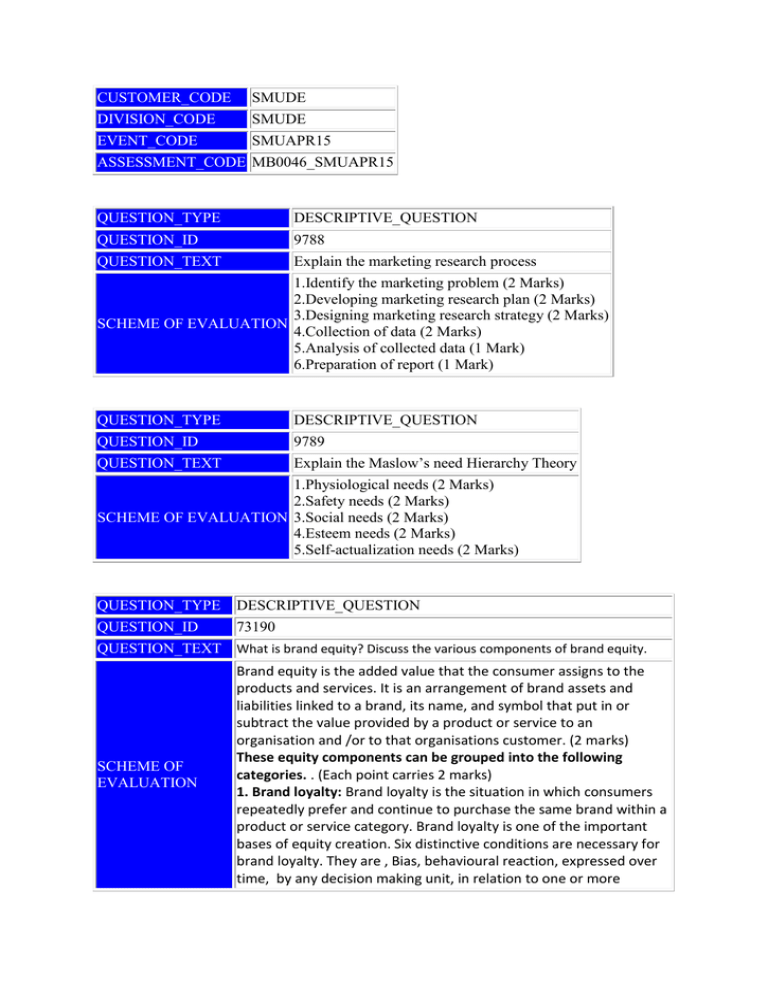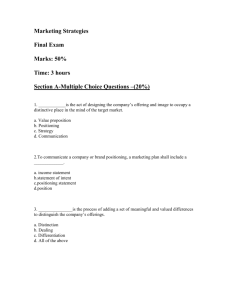CUSTOMER_CODE SMUDE DIVISION_CODE SMUDE
advertisement

CUSTOMER_CODE SMUDE DIVISION_CODE SMUDE EVENT_CODE SMUAPR15 ASSESSMENT_CODE MB0046_SMUAPR15 QUESTION_TYPE DESCRIPTIVE_QUESTION QUESTION_ID 9788 QUESTION_TEXT Explain the marketing research process 1.Identify the marketing problem (2 Marks) 2.Developing marketing research plan (2 Marks) 3.Designing marketing research strategy (2 Marks) SCHEME OF EVALUATION 4.Collection of data (2 Marks) 5.Analysis of collected data (1 Mark) 6.Preparation of report (1 Mark) QUESTION_TYPE DESCRIPTIVE_QUESTION QUESTION_ID 9789 QUESTION_TEXT Explain the Maslow’s need Hierarchy Theory 1.Physiological needs (2 Marks) 2.Safety needs (2 Marks) SCHEME OF EVALUATION 3.Social needs (2 Marks) 4.Esteem needs (2 Marks) 5.Self-actualization needs (2 Marks) QUESTION_TYPE DESCRIPTIVE_QUESTION QUESTION_ID 73190 QUESTION_TEXT What is brand equity? Discuss the various components of brand equity. SCHEME OF EVALUATION Brand equity is the added value that the consumer assigns to the products and services. It is an arrangement of brand assets and liabilities linked to a brand, its name, and symbol that put in or subtract the value provided by a product or service to an organisation and /or to that organisations customer. (2 marks) These equity components can be grouped into the following categories. . (Each point carries 2 marks) 1. Brand loyalty: Brand loyalty is the situation in which consumers repeatedly prefer and continue to purchase the same brand within a product or service category. Brand loyalty is one of the important bases of equity creation. Six distinctive conditions are necessary for brand loyalty. They are , Bias, behavioural reaction, expressed over time, by any decision making unit, in relation to one or more alternative brands and is a functional task of psychological processes. 2. Brand awareness: brand awareness is the ability to identify a brand under different conditions. It includes brand recognition and brand recall. Brand recognition is known as the capacity to verify prior exposure and recall is the capacity to consider the brand when a product category is thought about. This type of awareness is necessary for a brand to be included in the decision process. 3. Perceived quality: the quality may be objective or perceived. The objective quality indicates the actual superiority of product or service though the perceived quality is perception of excellence of a product or service in relation to its intended function. Perceived quality is customer based a customer may satisfied with poor quality. Satisfaction is determined by expectations. 4. Brand associations: the customer associates the attribute of the brand with his/her belief. Attributes are descriptive features which are used to characterise a product or service. The attributes may be differentiated on the basis of how directly they are associated with the performance of the product or service QUESTION_TYPE DESCRIPTIVE_QUESTION QUESTION_ID 73193 QUESTION_TEXT Explain the various characteristics that affect the consumer buying behavior? SCHEME OF EVALUATION Influence of cultural factors Culture Subculture Social class Influence of social factors Reference group Family Role and status Influence of personal factors Psychological factors Motivation Perception Selective attention Selective distortion Selective retention Learning Attitude QUESTION_TYPE DESCRIPTIVE_QUESTION QUESTION_ID 73197 QUESTION_TEXT Briefly explain the tools and techniques of sales and promotion. SCHEME OF EVALUATION Sales promotions directed at consumers 3.5M Sales promotions directed at trade partners 3.5M Sales promotions directed at sales force 3M with explanation QUESTION_T DESCRIPTIVE_QUESTION YPE QUESTION_I D 126172 QUESTION_T Differentiate between selling and marketing concepts. EXT SCHEME OF EVALUATIO N Differences Between Selling and Marketing Concepts





